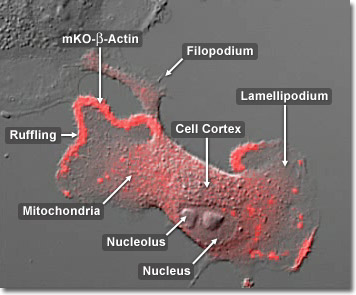Found in virtually all eukaryotic cells, actin is a highly conserved globular protein that differs in amino acid sequence by less than 20 percent in species ranging from algae to humans. Actin is one of three major components of the cytoskeleton (along with tubulin and intermediate filaments) and is involved in a variety of important cellular functions, including muscle contraction, cell motility, division, organelle tranlation, signaling, and the establishment of "communication" junctions between cells. The confocal digital video presented above captures several rabbit kidney epithelial cells (RK-13 line) as they progress across the glass coverslip, extruding and contracting the leading edges of their lamellipodia, a process that mimics ocean waves crashing onto the beach. The actin in this specimen is labeled with mKusabira Orange fluorescent protein.
Video 1 - Run Time: 57 Seconds
Video 2 - Run Time: 59 Seconds
Video 3 - Run Time: 52 Seconds
Video 4 - Run Time: 28 Seconds
The structural support provided by the microtubule network throught the cell is such that it resists compression, whereas actin microfilaments bear the tension of pulling forces. Actin filaments, when combined with other proteins and structures, become stronger and more specialized to perform various tasks within and between cells. In muscle cells, the motor protein myosin is arranged in a lattice configuration between parallel actin filaments. This array of filaments and proteins allows them to slide past each other, providing the elasticity necessary for muscle contraction. In a cell undergoing mitosis, this same actin-myosin pairing is responsible for the cleavage that eventually separates the cell into two daughter cells. The confocal digital video presented above captures several rabbit kidney epithelial cells (RK-13 line) as they progress across the glass coverslip, extruding and contracting the leading edges of their lamellipodia, a process that mimics ocean waves crashing onto the beach. The actin in this specimen is labeled with mKusabira Orange fluorescent protein.

The rate of growth of an actin filament is influenced by the rate of hydrolysis of the ATP-containing actin monomers. As long as monomers of ATP-actin add to the filament end faster than the embedded ATP in the filament can be hydrolyzed, the filament will continue to grow. The ATP-actin added to the end forms an "ATP cap" that keeps the embedded energy precursor from being hydrolyzed. If actin concentrations fall within the cell, the ATP at the ends will be hydrolyzed faster than the actin monomers are added, therefore slowing the rate of growth of the filament. Because the so-called "pointed" ends of an actin filament grow at a slower rate than the "barbed" ends, the ATP cap may disappear leaving ADP-embedded actin exposed. The confocal digital video presented above captures several rabbit kidney epithelial cells (RK-13 line) as they progress across the glass coverslip, extruding and contracting the leading edges of their lamellipodia, a process that mimics ocean waves crashing onto the beach. The actin in this specimen is labeled with mKusabira Orange fluorescent protein.